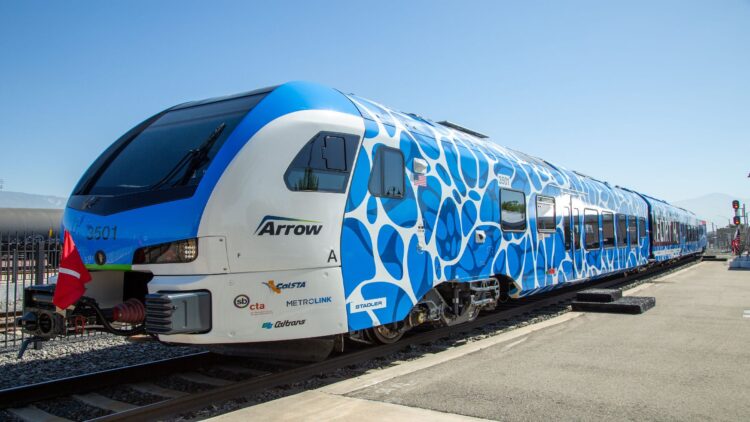The Hyperloop envisioned by Tesla was once seen as the transportation of the future for high-speed travel, but what California is brewing could outdo it. Meet the ZEMU, a zero-emission multiple-unit passenger train that combines energy efficiency and innovation in the use of hydrogen fuel.
Intended to transform rail transport in North America, ZEMU represents the principles of environmentally friendly California. The train’s futuristic look and its ability to operate without a single emission make it an excellent start to develop environmentally friendly means of transport. Now, let’s take a look at what makes ZEMU stand out.
A cleaner rail revolution: How ZEMU leads the way in zero-emissions
ZEMU is not just another commuter train of California but a symbol of change. It relies on hybrid hydrogen fuel cells and batteries to do so, replacing the diesel engines that are characteristic of trains. The result? The only emission is water vapor, which will benefit San Bernardino County, where air pollution has always been an issue due to freeways and rail yards.
The ZEMU can be seen as a significant achievement because it is the first hydrogen-powered train to meet North America’s Federal Railroad Administration (FRA) requirements. Its operation on the Arrow Corridor, connecting San Bernardino and Redlands, shows that clean energy trains are no longer exclusively European. More importantly, the ZEMU represents the change that embraces environmentally sensitive public transport.
In addition to environmental impacts, the ZEMU is more comfortable for passengers through quieter and smoother travel than noisy diesel. It is made from lightweight aluminum to increase energy efficiency and to conform to safety measures required in case of sharing tracks with freight trains. This innovation could help other states in the United States follow the same by adopting hydrogen-powered trains.
How ZEMU beats traditional rail systems and Hyperloop dreams
However, Elon Musk’s Hyperloop idea of moving at the speed of a_url Raleigh wondered whether supersonic travel by rail was feasible as it was still mostly on paper due to cost and technological restraints. Instead, ZEMU presents a realistic and proven way of meeting the contemporary requirements of rail transport services. Since it will cost $20 million to establish, this is far from the billions necessary for Hyperloop construction, which should make it attainable for cities seeking eco-friendly transport systems.
It is timely that ZEMU is introduced when California is set to host the 2028 Olympics, a “car-less” event that will encourage the use of public transport. DOT has already purchased 10 longer ZEMU units for future routes and is stressing the scalability of the service. In contrast to Hyperloop, which is based on the new construction of tracks, ZEMU is built to integrate with existing rail systems, which is more feasible.
Using hydrogen fuel cell technology, ZEMU achieves emission reduction and does not require costly electrification of tracks, a factor common in European systems but less possible in the United States. This innovation enables it to operate efficiently in freight-dominated environments that other concepts fail to address, such as the practicality of sustainable transport.
Challenges and potential: What ZEMU means for the future of travel
However, ZEMU has challenges, especially in hydrogen fuel and infrastructure generation. Hydrogen fuel involves energy-demanding processes, more often relying on fossil energy sources. Some critics have said that a total emphasis on renewable diesel could produce a quicker change. However, California is still investing $12.6 billion into hydrogen initiatives, such as manufacturing facilities and vehicles.
ZEMU is also a proof-of-concept company and is only in its beginning stages with its nine-mile Arrow Corridor. Getting to the level of a full-fledged hydrogen rail transport system will necessitate massive capital outlay and further technological developments. Still, it could encourage other states to follow suit, revolutionizing how America thinks about clean rail transport.
Critics have long highlighted hydrogen’s drawbacks, but proponents consider it an element of a more extensive renewable power system. ZEMU may not capture the grand utopian vision of Hyperloop, but it is realistic and offers a tremendous value proposition for the speed of regional transit.
California’s ZEMU is a practical, progressive advance in green rail transport. From an environmental perspective, it is a hydrogen-powered zero-emission train; from the passengers’ perspective, it is smoother, quieter, and faster. However, the progress made in the project shows that it is flexible and can be improved, which makes it different from thought-out solutions, such as Hyperloop. The success of ZEMU may open the gates for safe, efficient, and eco-friendly transportation in California and the world. The new age of rail transport is already with us and set to grow even further.

